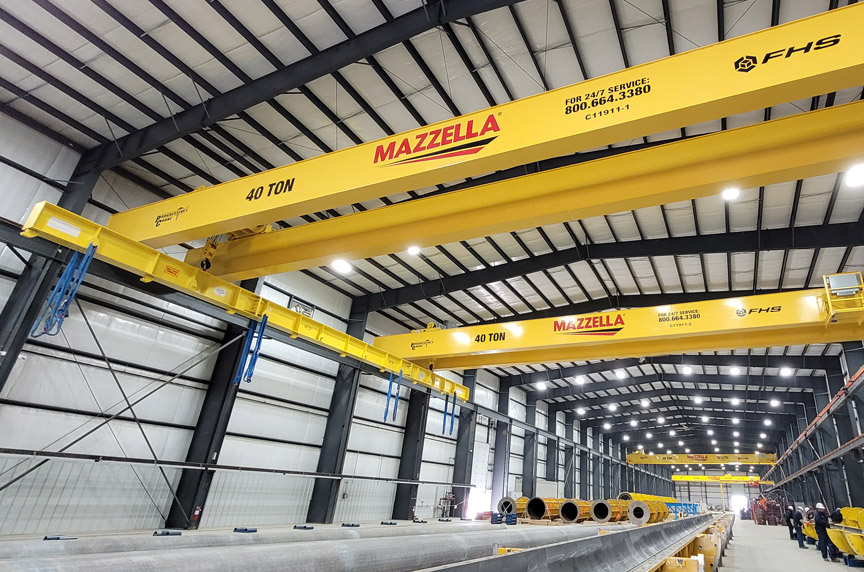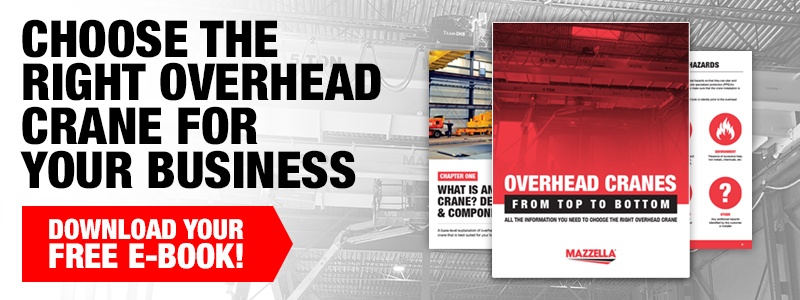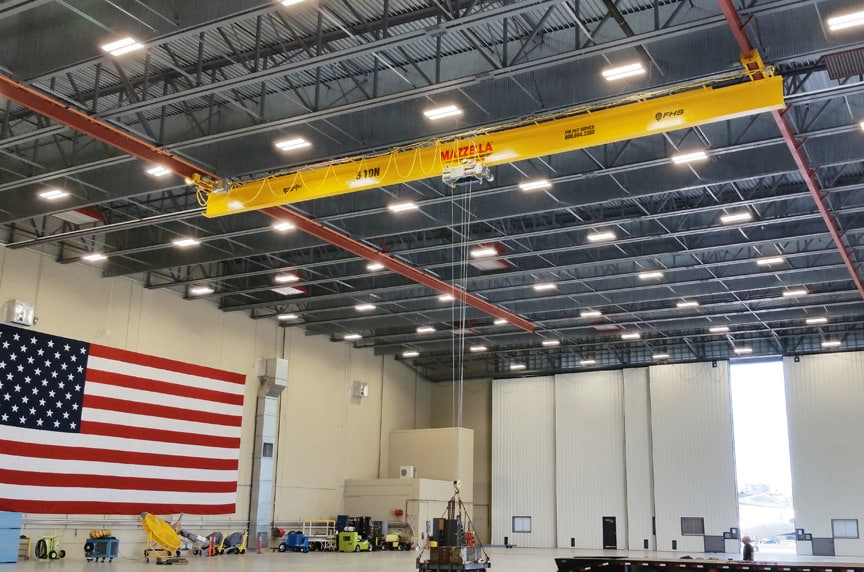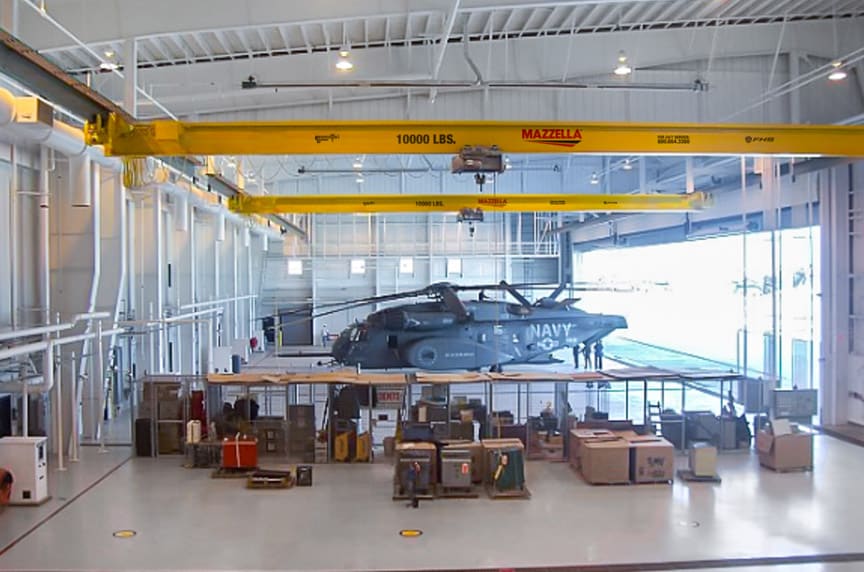Top Running vs. Under Running Cranes: Definitions and Comparisons
Top running cranes vs. under running cranes: learn more about the differences, capabilities, advantages, and common applications for both types of overhead crane designs.
One of the most common questions that we receive from customers during the consultation, design, and quotation process is whether they need a top running or under running overhead crane system.
At Mazzella, we design and build overhead crane systems in every type of configuration imaginable. With so many different options available, careful consideration needs to be given to selecting a top running or under running crane configuration.
The following factors can help you determine whether a top running or under running system will be best for your facility and business needs:
- Can the existing support structure be utilized or will a new support structure need to be built?
- Are there existing runways in the facility that the crane can be installed on?
- What is the capacity of the loads that you’ll be lifting?
- What type of overhead room is available? High, unobstructed ceilings, or limited headroom due to existing cranes, ductwork, light fixtures, etc.?
- How high will your lifts need to be?
- Hook approach – how much of the crane’s bridge will the hoist trolley need to utilize? Do you need to make picks or lifts near the edges or sides of the building?
- How important is free and clear floor space?
Our goal for this article is to explain the differences between a top running and under running cranes and also present the capabilities, advantages, and applications for each type of overhead crane design.
Top Running Overhead Cranes

A top running overhead crane has a fixed rail or track system installed on the top of each runway beam—allowing the end trucks to carry the bridge and hoist along the top of the runway system. Top running cranes can be configured in a single girder or double girder bridge design. A single girder bridge utilizes an underhung trolley and hoist, while a double girder design most often utilizes a top running trolley and hoist.
Top running overhead cranes have no limiting capacity—meaning that they can be built to handle small capacity loads or large capacity loads. Top running cranes can be built to capacities of anywhere from 1/4-ton to excesses of 100-tons. These types of overhead cranes are supported by the building structure or runway support columns and are ideal for moving extremely heavy loads.
Top running cranes provide added lift height for buildings with limited headroom because they ride on rails on top of the runway beam. A top running double girder bridge design allows the greatest lifting height because the hoist and trolley run on top of the two bridges or girders—adding anywhere from an extra 3 to 6 feet of hook height.
Top running overhead cranes are typically larger than under running cranes, as they can be built to higher capacities and can accommodate wider spans.
Because the crane is supported on rails on top of the runway beams, there is no suspended load factor, so installation and future service or maintenance is easier and less time-consuming than an under running crane.
Over the course of its life, the track or rail system that the bridge moves on may need to be checked for alignment or tracking problems more frequently than an under running crane. Fortunately, the service and alignment inspections are fairly easy to perform and require less downtime than an under running crane.
Benefits of a Top Running Single Girder Crane:
- Typical Load Capacity: 1/4-ton to 20 tons
- Typical Span: Under 65 feet
- Typical Service: Light to medium duty
- Common Applications: Light manufacturing, fabrication and machine shops, light assembly line, warehousing facilities, maintenance and repair centers
- Low deadweight
- More overhead space
- Faster hoist and trolley speed
- Lower production cost / lower overall price with less material required
Benefits of a Top Running Double Girder Crane:
- Typical Load Capacity: 20-400 tons
- Typical Span: Over 65 feet
- Typical Service: Medium to heavy duty
- Common Applications: Steel and metal mills, coil handling, foundries, large fabrication and stamping facilities, paper mills, casting plants, large-scale tool and die facilities
- Allows for best hook and lifting height because hoist and trolley can run on top of the two bridge girders
- Provides the most overhead floor space
- High speed

Under Running / Underhung Overhead Cranes

An under running crane, or commonly referred to as an “underhung” crane, uses wheels that are supported by the bottom flange of the runway beam to move the bridge up and down the runway. Under running cranes are most commonly configured in a single girder design for lighter service and lower-capacity applications. They can also be built in a double girder design for higher capacities but it can become impractical and expensive to design and engineer.
An under running single girder crane will utilize an under running hoist and trolley which moves across the bottom flange of the bridge beam. A double girder under running crane can run its hoist and trolley along the top or the bottom of the bridge beams.
These underhung types of cranes can allow you to maximize your facility’s floor space for production and storage of material because they are most commonly supported from the existing ceiling trusses or the roof structure. Underhung cranes also offer excellent side approach and maximize utilization of the building’s width and height when supported by roof or ceiling structures. They’re ideal for facilities that lack vertical clearance to install a top-running overhead crane system.
Under running cranes can be designed in a free-standing configuration if the building’s existing support structure can’t be utilized, but this setup does require the use of support or mounting columns.
Hook height and lift height is less than top running cranes because the bridge and hoist hang underneath the runways.
When it comes to the installation and service of an under running crane system, it can be more of a complex procedure leading to longer downtime. Because the crane is suspended from the runways, it can take longer to check the alignment or service the wheels of the crane, but it is easier to dial in and maintain the alignment and there are fewer tracking problems because it runs on an I-beam which is secured to building structure—limiting movement.
Benefits of an Under Running Overhead Crane:
- Typical Load Capacity: 1/4-ton to 15-tons
- Typical Span: Under 65 feet
- Typical Service: Light to medium duty
- Common Applications: Assembly, fabrication shops, maintenance buildings, and manufacturing facilities
- Maximizes floor space if supported by existing ceiling trusses or roof structure
- Reduces material costs if no runway support columns are needed
- Increased end hook approach and bridge beam and hoist are underneath runway beams
Wrapping it Up

Hopefully you have a better sense of whether a top running crane or an under running crane will be the most beneficial for your material handling needs. Under running cranes offer flexibility, functionality, and ergonomic solutions, while top running crane systems offer the advantage of higher capacity lifts and allow for higher lift heights and more overhead room.
At Mazzella, we have over 50 years of experience in the overhead crane industry and can build custom solutions ranging from light-duty economical cranes to large-capacity, high-duty cycle cranes.
We rely on the experience and expertise of our team of draftsmen, estimators, engineers, and project managers to design and build an overhead crane system that fits your budget and your specific business needs. If you’re interested in receiving a quote on a new overhead crane system, contact one of our Crane Specialists today to set up a free consultation.

Copyright 2017. Mazzella Companies.
